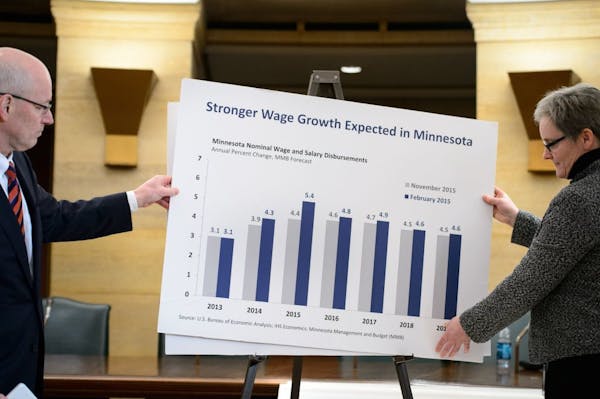Republican leaders in the Minnesota House outlined a $40 billion budget blueprint Tuesday, $3 billion less than what Gov. Mark Dayton has proposed, setting up a clash with DFLers who sharply criticized the plan.
The centerpiece is $2 billion of as-yet unspecified tax relief. That would be just a little more than the state's projected budget surplus of $1.9 billion and fits in with an earlier ad campaign by state Republican Party Chairman Keith Downey to "give it all back."
The budget overall largely holds the line on spending, with modest increases in certain areas and some potential for service cuts because the Republican plan does not account for inflationary pressures in the cost of delivering services.
If adopted, the GOP budget would increase total state spending by 1.7 percent from current levels, compared with 9.3 percent under Dayton's plan.
"Our priority, really, is to put money in the pockets of hardworking Minnesota families," House Speaker Kurt Daudt said Tuesday, flanked by key Republican House leaders.
Daudt did not explain how they plan to distribute $2 billion in tax relief, but said it would not be in the form of individual rebate checks.
DFL leaders immediately denounced the GOP budget proposal, saying Republicans could not defend reductions in services with the prospect of a $2 billion surplus. Republicans say they are merely slowing the rate of growth.
Republicans say they will spend $11.6 billion on health and human services in the 2016-17 budget period — an increase of $440 million over the current allotment. But the Minnesota Management and Budget office puts projected costs for providing the services mandated under current law for the next two years at $12.8 billion. DFLers say that translates into a $1.2 billion cut in the services that agency can provide.
"That's real cuts to people in this state in a time of huge budget surpluses," said House Minority Leader Paul Thissen, DFL-Minneapolis. The GOP plan, he said Tuesday, "is a recipe for a shutdown." The last government shutdown occurred in 2011, when Republicans who controlled the House and Senate clashed with Dayton.
Matt Swenson, a spokesman for Dayton, said the governor's office is reviewing the budget spending limits and declined to comment further.
Senate DFL leaders were planning to meet Tuesday evening to discuss their budget targets, which they expect to announce Friday.
Senate Finance Chairman Dick Cohen, DFL-St. Paul, said the Republican plan is likely to lead to rocky budget negotiations.
"The numbers would suggest it's going to be a very difficult session," Cohen said. "It does not look as if they're looking to establish a middle ground anywhere … And if that's the case, it makes compromise very, very difficult, if not impossible."
Democrats weren't the only ones to criticize the proposed spending limits. The Minnesota Tea Party Alliance, comprising the most conservative members within the GOP, called the plan "a slap in the face to conservatives" because it did not cut government below current spending levels.
Republicans offered few details of how they would achieve even the $1 billion reduction in health and human services programs. House Ways and Means Chairman Jim Knoblach, R-St. Cloud, said he hopes a large portion comes from culling ineligible people from the rolls of MinnesotaCare. Further details will emerge in the coming weeks as House committees chew over spending levels, he said.
Republicans would also dedicate new dollars to both public schools and public colleges, although $775 million less than what Dayton wants in additional new resources. While Dayton's proposed funding boost for higher education would allow two more years of tuition freezes at University of Minnesota and MnSCU schools, Knoblach said the GOP plan would probably only allow such a freeze at only one of the two college systems.
Republicans would significantly trim spending in a couple areas. Agencies administering environmental and economic development programs would get less money in the next two years than they did in the last two.
The GOP plan also directs $100 million into state reserve funds, and leaves $319 million unallocated for the time being. Knoblach said that could later be added to the reserves, as a hedge against a future economic downturn or might still be spent in some fashion. DFL Senate leaders have also said they plan to divert some portion of the surplus to the state reserve.
Republicans left out a chunk of spending from Tuesday's plan. They did not include in their total budget the more than $600 million in general fund dollars they would divert to road and bridge repairs in the next two years. Once that is factored in, the gap between the Dayton and GOP plans closes a bit.
With the House GOP proposing $40 billion in spending and Dayton at $43 billion, Senate Majority Leader Tom Bakk, DFL-Cook, has said their total spending figure would likely fall somewhere between Dayton and Daudt.
After Friday, lawmakers leave St. Paul for a 10-day spring break. Upon returning, they'll launch into a six-week home stretch that will focus on passing a final state budget ahead of the May 18 adjournment deadline.
Patrick Condon • 651-925-5049
Ricardo Lopez • 651-925-5044
